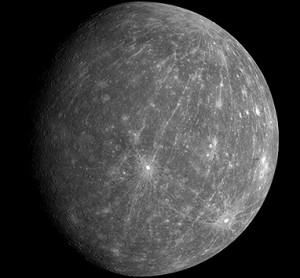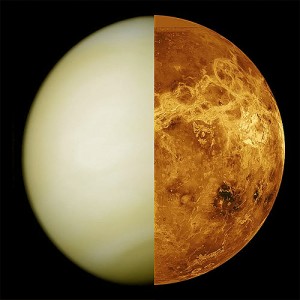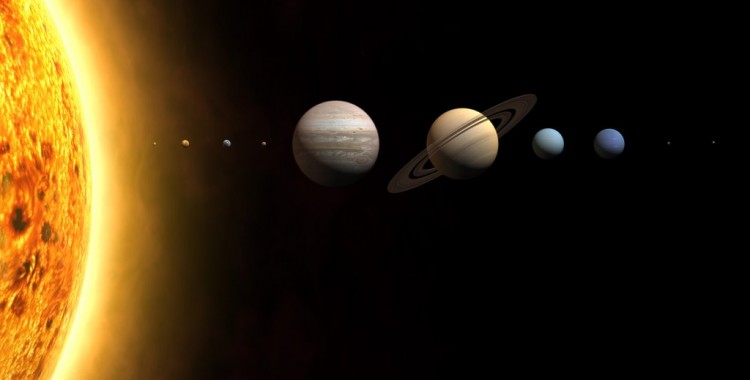
You can learn more about the 8 major planets of our Solar System below. Click here to find the planets in the sky (rising and setting times, as well as max degrees altitude above the horizon)
Planet: MercuryDiameter: 4,879 km
Mass (Earth=1): 0.2 Distance from Sun: 58 million km Average temperature: 167 C Length of day: 2 months Length of “year”: 88 days Moons: 0 The lowdown: Despite the fact that it’s not that far from Earth, Mercury has been a mystery for decades, largely due to the fact that its closeness to the Sun makes observing it so hard. Somewhat similar to the Moon, Mercury is a largely-dead, cratered world. In-fact, it has so many craters that the craters inside some of its craters have craters. No spacecraft have ever landed on Mercury, but the Mariner 10 and Messenger space probes flew by in 1973 and 2008, when Mercury’s far side was photographed for the first time. Fun facts:
- Despite being closest to the Sun, Mercury isn’t the hottest planet. But it does have the greatest temperature variation: Its night side freezes at -173 C while its sunlit side bakes at 430 C
- Mercury’s gigantic Caloris impact basin is larger than Texas
Finding it in the sky: Using software like Starry Night, aps like Star Walk, or monthly charts in magazines like Sky News, you can find out when Mercury will be far enough from the Sun to see it. What you’ll see through binoculars: In any binoculars, Mercury will appear as as a dim orange “star” at dawn or dusk. What you’ll see through a telescope: Even at its farthest from the Sun, Mercury will appear as a wavy, orange marble or half-circle, like a tiny first-quarter Moon.
Planet: Venus Diameter: 12,104 km Mass (Earth=1): 0.8 Distance from Sun: 108 million km Average temperature: 464 C Length of day: 243 days, rotates “backwards” Length of “year”: 225 days Moons: 0 The lowdown: Once thought to be Earth’s tropical “twin”, space probes have long since shattered that dream: In fact, Venus (along with Jupiter’s moon Io) is probably the closest real-life approximation to Hell in the known-universe. The hottest planet by far, Venus’ surface is hot enough to melt lead. It’s atmospheric pressure is a skull-crushing 92-times that of Earth and is streaked with constant lightening strikes and rain of sulfuric acid. Fun facts:
- The only probe to successfully land on Venus only survived a few minutes…before melting
- Venus rotates “backwards” on its axis, compared to the other planets, which rotate counter-clockwise (instead, Venus rotates “clockwise” as seen from north of the solar system
- Venus has the largest solid surface of any body in the solar system
- Compared to the other planets in the Solar System, Venus rotates backwards
Finding it in the sky: Using software like Starry Night, aps like Star Walk, or monthly charts in magazines like Sky News, you can find out when Venus will be far enough from the Sun to see it. What you’ll see through binoculars: In any binoculars, Venus usually appears as as a blazing white-yellow “star.” When in its maximum crescent phase, you may even be able to see the “sickle” of Venus in binoculars. What you’ll see through a telescope: While many planets dazzle in details but disappoint in apparent size, Venus delivers the goods when it comes to this. At it’s closest to Earth, Venus appears more than twice the size of Jupiter and all the other planets seen from Earth combined and looks like a mini crescent moon at high magnification. Farther from Earth, but more illuminated from the Sun, Venus’ highly reflective atmosphere often creates a crazy “starburst” effect in many telescopes, especially when it has to shine through thick layers of Earth’s atmosphere on our horizon, at dusk or dawn.
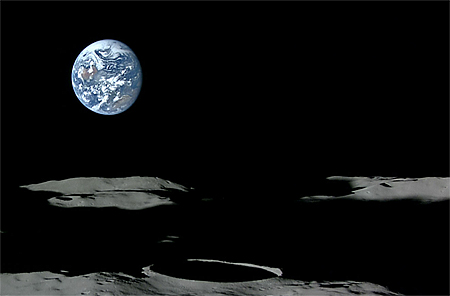
A still from the first-ever HD video of the Earth, taken by NHK TV and the Japanese Kayuga probe in lunar orbit in 2007
Planet [er, Moon]: Earth’s Moon Diameter: 3,475 km Mass (Earth=1): 0.01 Distance from Sun: 150 million km Average temperature: -20 C (Earth is 15 C) Length of day: 1 month Length of “year”: 1 Earth year (or 27.3 days to orbit the Earth) Moons: N/A the Moon is Earth’s only-known natural satellite The lowdown: Long a subject of fascination, the Moon is probably the first thing every civilization really noticed in the sky. Since the days of ancient cave paintings to the writings of Jules Verne, we’ve yearned to travel to our neighbour in space – only 1/3 of a million km away. Sadly, we haven’t made the 3-day journey since the late 1960s and early 70s, when Cold War nationalism compelled the U.S. and its partners to found NASA and take that first small step for humanity. Fun facts:
- The great lunar crater Copernicus is more than a billion years old
- The dark areas on the Moon called “seas” are ancient lava flows
- Because there’s no weather and almost on atmosphere, the Moon serves as a “museum” of the early days of our Solar System.
- If left undisturbed, footprints of NASA’s Apollo astronauts should remain unchanged on the Moon for at least a million years
- We’ll probably be going back to the Moon soon now, but it will likely be private companies like SpaceX and Virgin Galactic that will go there, as opposed to government-run space agencies (supposedly to visit the Coca-Cola/AT&T Wireless crater on the edge of the Ford Trucks mountain range ; )
Finding it in the sky: Seeing the moon in the day or evening sky isn’t too hard, unless you’re looking for a slim crescent before dusk or just after dawn. You can find this and different phases using software like Starry Night, aps like Star Walk, or monthly charts in magazines like Sky News. Meanwhile, here’s a really good basic map of the moon, with seas, major craters, and NASA landing sites labelled. What you’ll see through binoculars: One of the true joys of binocular viewing is the 3D view of lunar craters, valleys and mountain ranges. A standard pair of 7×50 binocs, will provide a lifetime worth of lunar exploration of hundreds of features. What you’ll see through a telescope: With a low-power eyepiece, you’ll get a completely mind-blowing experience of seeing the features of the moon close-up all at once. Look at the moon a few days before or after it’s full so the shadows bring out more relief in craters and ridges. Pile on the highest-power eyepiece you’ve got for a view similar to the one you’d have from lunar orbit or a close-approach before landing!

A composite of Mars images, showing the hemisphere featuring the Mariner Valley and the Tharsis bulge mountain chain of extinct volcanoes
Planet: Mars Diameter: 6,792 km Mass (Earth=1): 0.1 Distance from Sun: 228 million km Average temperature: -65C Length of day: 24.7 hours Length of “year”: 2 Earth years Moons: 2 The lowdown: At present, Mars bears more resemblance to Earth than any other place in the universe: It has a moderate atmosphere, weather patterns such as dust storms and seasons. While not made of water, Mars has polar ice caps that recede and advance with the passage Martian summer and winter. And four fruitful orbital and lander/rover missions have uncovered definitive proof that large amounts of water once existed on Mars, while small amounts of liquid water seem to flow on Mars to this day. Such probes have even discovered Martian permafrost at the poles and videotaped “dust devils” swirling across the surface. Fun facts:
- Because of a lack of tectonic plates, Mars has some of the largest geological formations in the Solar System, including the tallest, largest mountain (Olympus Mons, 3 times taller and dozens of times larger than Everest) and the longest, deepest above-water valley
- Mars’ “red” soil is literally rusting, as iron in the soil oxidizes
- A human mission to Mars could cost up to $1 trillion US
- Despite a longstanding email scam to the contrary, Mars will never appear as large as the full Moon from Earth and its closest approach for thousands of years came in 2003
- To go to Mars, we’d have to master long-duration spaceflight, extending missions on the International Space Station from 6 months to 2 years, and create a launch vehicle capable of carrying a crew and multiple surface landing/roving/escape/supply vehicles to the Red Planet
Finding it in the sky: Every two years, the Red Planet meets up with the Earth at its closest approach to our planet. Using software like Starry Night, aps like Star Walk, or monthly charts in magazines like Sky News, you can find out when Mars will be visible as a relatively bright orange “star.” What you’ll see through binoculars: In any binoculars, Mars will appear as as a dim-to-bright orange “star”, depending on where it is in its orbit. What you’ll see through a telescope: During its bi-yearly close-approach, Mars goes from being a frustratingly-small orange marble to a feature-filled “grape” (if you held a grape at arms’ length) at especially favourable close approaches. During this time, you can see dark markings on the surface, including the triangular Syrtis Major, and fuzzy white buttons at the poles, which are Mars’ ice caps.
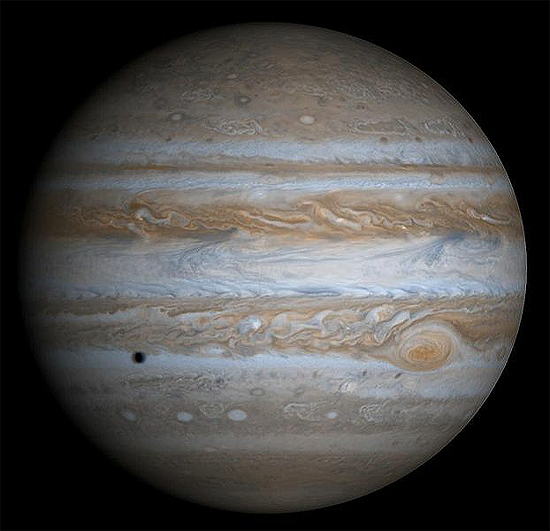
A 2004 Cassini spaceprobe image of Jupiter – more than 1,300 times the size of Earth. The shadow of the Jovian moon Europa is seen here on the surface, at the same latitude as the Great Red Spot, a 300-year-old anti-cyclone so big it could swallow the entire Earth, twice.
Planet: Jupiter Diameter: 139,822 km Mass (Earth=1): 318 Distance from Sun: 779 million km Average temperature: -110 C Length of day: 10 hours Length of “year”: 12 Earth years Moons: 67 The lowdown: At more than 1,300 times the size of Earth by volume, Jupiter – king of the gas giants – could fit all the other planets, AND dwarf planets, AND 175+ moons inside it. With a family of major moons that are as big or bigger than some planets and most dwarf planets, you could consider Jupiter a sort-of Solar System within a Solar System. In-fact, helium-and-hydrogen-filled Jupiter is so large that it would only have to be about 6-dozen times bigger to potentially ignite and become a star. Fun facts:
- As far down as we can detect, Jupiter’s moon Europa is made up almost completely of water. (The bad news for a search for life of exploitation as a refueling stop-off is that all that water seems to be frozen – Perhaps further below the surface, a liquid water sea might exist.)
- Jupiter’s moon Io is the most volcanically-active place in the Solar System, with a dozen peaks simultaneously spewing sulfur straight into space. Scientists theorize that because of this, Io completely resurfaces itself every million years or so.
- Jupiter’s moon Ganymede is the largest in the Solar System, out-sizing Mercury, Pluto, and almost Mars
- Jupiter’s 300-year-old storm called the Great Red spot is so large at present, it could swallow two Earths
Finding it in the sky: Using software like Starry Night, aps like Star Walk, or monthly charts in magazines like Sky News, you can find out when Jupiter will be visible. Because it orbits much farther out from the Sun than Earth, Jupiter tends to stay in one area of our sky over several years. What you’ll see through binoculars: In any binoculars, you’ll be able to see the tiniest of marbles making up the disc of the giant planet. People with very good eyesight may be able to pick out one of the planet’s 4 major moons as tiny “stars” left and/or right of the planet. What you’ll see through a telescope: Seeing the cloudtops of Jupiter through a telescope is one of the true, great joys of amateur astronomy. Even a small telescope will reveal the four major moons and the two most prominent bands of gas revolving around the colossal planet. Larger telescopes will reveal fainter bands of gas and storms like the Great Red Spot, Red Spot II and the Great White spot. 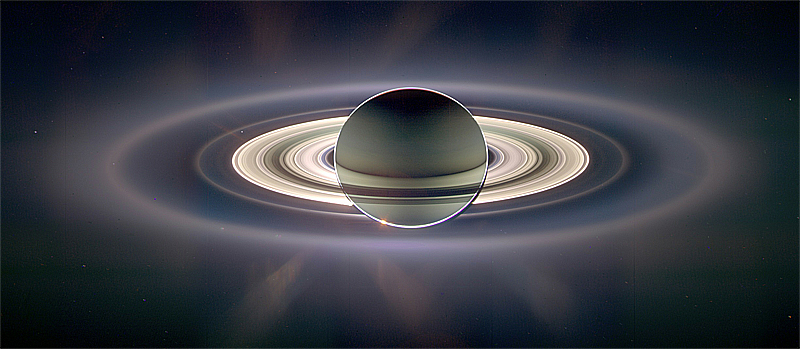 Planet: Saturn Diameter: 116,464 km Mass (Earth=1): 95 Distance from Sun: 1.4 billion km Average temperature: -140 C Length of day: 11 hours Length of “year”: 29 Earth years Moons: 62 The lowdown: Perhaps the most beautiful of all the sights in astronomy, the rings of Saturn are actually trillions of particles of dust and ice that may once have been a small moon that was either destroyed or never had the chance to form into a moon in the first place. Like the rest of the four gas planets (Jupiter, Saturn, Uranus, Neptune), Saturn’s lightening-and-aurora-strewn gases swirl around the planet at incredible speed (despite its size – as with Jupiter – Saturn’s day is less than half as long as Earth’s) causing it to bulge at the centre: So if Saturn or Jupiter look a bit like they’re ovals, it’s because they actually are! As if Saturn itself wasn’t interesting enough on its own, its moon Titan is perhaps the #1 candidate for life beyond Earth. Fun facts:
Planet: Saturn Diameter: 116,464 km Mass (Earth=1): 95 Distance from Sun: 1.4 billion km Average temperature: -140 C Length of day: 11 hours Length of “year”: 29 Earth years Moons: 62 The lowdown: Perhaps the most beautiful of all the sights in astronomy, the rings of Saturn are actually trillions of particles of dust and ice that may once have been a small moon that was either destroyed or never had the chance to form into a moon in the first place. Like the rest of the four gas planets (Jupiter, Saturn, Uranus, Neptune), Saturn’s lightening-and-aurora-strewn gases swirl around the planet at incredible speed (despite its size – as with Jupiter – Saturn’s day is less than half as long as Earth’s) causing it to bulge at the centre: So if Saturn or Jupiter look a bit like they’re ovals, it’s because they actually are! As if Saturn itself wasn’t interesting enough on its own, its moon Titan is perhaps the #1 candidate for life beyond Earth. Fun facts:
- Saturn’s moon Titan’s atmosphere is about 95% nitrogen, 5% methane and trace gases (Earth’s is about 71% nitrogen – not bad considering nothing else in the Solar System is even close)
- A “floating” lander confirmed with readings and photographs in 2004 that Titan contains hydrocarbons (basically swamp gas mixed with smog) which are thought to have contained the building blocks of life on early Earth
- That same probe confirmed the Titan is the only other place besides Earth known to have liquid lakes and seas (through Titan’s -170 C lakes are made of methane, not water)
- At 800 times the size of Earth, Saturn is runner-up to Jupiter as king of the planets, though its density is such that if a lake of water big enough to hold it existed, Saturn would float in it.
Finding it in the sky: Using software like Starry Night, aps like Star Walk, or monthly charts in magazines like Sky News, you can find out when Saturn will be visible. As with Jupiter, because Saturn orbits much farther out from the Sun than Earth, Saturn tends to stay in one area of our sky over several years. What you’ll see through binoculars: In any binoculars, the oval shape created by Saturn’s rings will be evident. Observers with high-power binoculars and good eyesight may even be able to pick out the rings from the planet, as well as one or two of Saturn’s larger moons. What you’ll see through a telescope: …Is nothing short of a life-transforming experience. Any telescope at all – even at low power – will clearly show the rings of Saturn, with larger, high-quality instruments showing details like the gap between the two largest rings segments – called Cassini’s Division – the shadow of the planet on the rings, the shadow of the rings on the planet, and more of Saturn’s moons, appearing as a network of tiny “stars.”  Planet: Uranus Diameter: 50,724 km Mass (Earth=1): 14 Distance from Sun: 2.9 billion km Average temperature: -195 C Length of day: 17 hours Length of “year”: 84 Earth years Moons: 27 The lowdown: First of all – let’s get this out of the way: It’s pronounced URanus, for the exact reason you’re probably wondering. Thousands of well-intentioned parents’-basement-dwelling planetarium staff couldn’t take it any longer, so don’t pronounce it the other way. Perhaps most interestingly, Uranus seems to have – at some point in its existence – been tipped on its side, orbiting like a giant bulls-eye in the skies of the Outer-Solar-System. This could have been the result of a titanic collision millions or billions of years ago. Fun facts:
Planet: Uranus Diameter: 50,724 km Mass (Earth=1): 14 Distance from Sun: 2.9 billion km Average temperature: -195 C Length of day: 17 hours Length of “year”: 84 Earth years Moons: 27 The lowdown: First of all – let’s get this out of the way: It’s pronounced URanus, for the exact reason you’re probably wondering. Thousands of well-intentioned parents’-basement-dwelling planetarium staff couldn’t take it any longer, so don’t pronounce it the other way. Perhaps most interestingly, Uranus seems to have – at some point in its existence – been tipped on its side, orbiting like a giant bulls-eye in the skies of the Outer-Solar-System. This could have been the result of a titanic collision millions or billions of years ago. Fun facts:
- All 27 of Uranus’ moons are named after characters from the works of Shakespeare and Alexander Pope
- Uranus has a substantial ring system, but unlike Saturn’s, Uranus’ rings are black as coal and practically invisible to all but the highest fidelity telescopes and space probe cameras
Finding it in the sky: Using software like Starry Night, aps like Star Walk, or monthly charts in magazines like Sky News, you can find out where and when to see Uranus – a moderate challenge for telescope and binocular users. What you’ll see through binoculars: Uranus will appear as a faint grey-blue/aquamarine star in any moderate sized (50mm and up) binoculars. What you’ll see through a telescope: Uranus appears as a faint blue featureless marble, barely larger than the point of light of a star in all but the most amazing amateur telescopes. Observation of a moon or two is technically possible in large consumer telescopes. 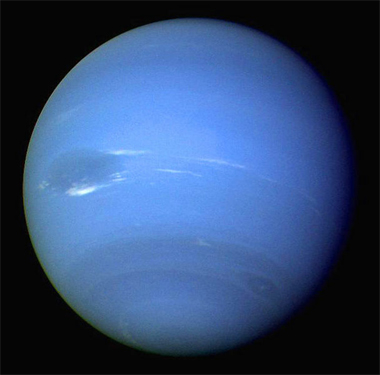 Planet: Neptune Diameter: 49,248 km Mass (Earth=1): 17 Distance from Sun: 4.4 billion km Average temperature: -200 C Length of day: 16 hours Length of “year”: 164 Earth years Moons: 13 The lowdown: “The last of the giants” is slightly smaller and slightly denser than its 2-billion km-distant cousin Uranus. Neptune is so far from our local star that it generates more internal heat than it receives from the Sun, which appears as a blazing star many times brighter than Venus as seen from Earth. Like Jupiter, Neptune has a ring system, but both are so dark and thin, they were invisible until passing space probes imaged them in the 1980s. Also like Jupiter, Neptune has a storm in its atmosphere. Neptune’s storm – imaginatively called the Great Dark Spot – is about the size of Africa. A transitional object between frighteningly big Jupiter and Earth, Neptune is just over a dozen times more massive then our own planet and could fit 60 Earths inside. Fun facts:
Planet: Neptune Diameter: 49,248 km Mass (Earth=1): 17 Distance from Sun: 4.4 billion km Average temperature: -200 C Length of day: 16 hours Length of “year”: 164 Earth years Moons: 13 The lowdown: “The last of the giants” is slightly smaller and slightly denser than its 2-billion km-distant cousin Uranus. Neptune is so far from our local star that it generates more internal heat than it receives from the Sun, which appears as a blazing star many times brighter than Venus as seen from Earth. Like Jupiter, Neptune has a ring system, but both are so dark and thin, they were invisible until passing space probes imaged them in the 1980s. Also like Jupiter, Neptune has a storm in its atmosphere. Neptune’s storm – imaginatively called the Great Dark Spot – is about the size of Africa. A transitional object between frighteningly big Jupiter and Earth, Neptune is just over a dozen times more massive then our own planet and could fit 60 Earths inside. Fun facts:
- Neptune’s moon Triton is the coldest-known place in the Solar System, only 38 C above absolute zero (-273 C)
- As with Saturn’s famed moon Enceladus, Triton sports a series of “ice geysers – in this case, erupting with deposits of nitrogen
- Until as recently as 1930, Neptune was the last-discovered-and-farthest-known planet.
Finding it in the sky: Using software like Starry Night, aps like Star Walk, or monthly charts in magazines like Sky News, you can find out where and when to see Neptune – a worthychallenge for telescope and binocular users. What you’ll see through binoculars: Neptune will appear as an extremely dull grey star in any moderate sized (50mm and up) binoculars. What you’ll see through a telescope: Neptune appears dull grey featureless marble, if you can even distinguish it from the points of light of faint stars nearby. Just seeing Neptune is an impressive achievement to tick-off your Solar System bucket-list. ALSO… At this writing (2016) there are close to a dozen “dwarf planets“, including the 1,000-km-wide (approx) asteroid Ceres between Mars & Jupiter, Pluto, and a half-dozen or so objects beyond Pluto.

